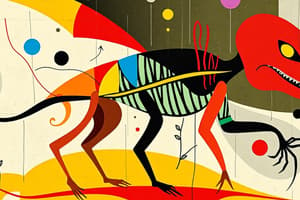Podcast
Questions and Answers
What is the hierarchy of groups in animal classification, organized from general to specific characteristics?
What is the hierarchy of groups in animal classification, organized from general to specific characteristics?
- Kingdom Family Genus Class Order Species
- Phylum Kingdom Class Order Genus Family Species
- Kingdom Phylum Class Order Family Genus Species (correct)
- Family Phylum Genus Kingdom Class Order Species
Which scientist revolutionized taxonomy in the 18th century with binomial nomenclature?
Which scientist revolutionized taxonomy in the 18th century with binomial nomenclature?
- Charles Darwin
- John Ray
- Gregor Mendel
- Carl Linnaeus (correct)
In animal classification, what is the process of grouping animals based on shared characteristics called?
In animal classification, what is the process of grouping animals based on shared characteristics called?
- Taxonomy (correct)
- Phylogeny
- Genetics
- Ecology
Which scientific field reshaped classification in the 20th century through advancements that introduced cladistics?
Which scientific field reshaped classification in the 20th century through advancements that introduced cladistics?
To what domain do microscopic organisms like yeasts, molds, and mushrooms belong?
To what domain do microscopic organisms like yeasts, molds, and mushrooms belong?
Which kingdom of life includes unicellular prokaryotic organisms like bacteria and archaea?
Which kingdom of life includes unicellular prokaryotic organisms like bacteria and archaea?
What is the main purpose of animal classification?
What is the main purpose of animal classification?
Who is credited with early attempts at animal classification based on habitat and characteristics?
Who is credited with early attempts at animal classification based on habitat and characteristics?
Why did different countries having different names for animals lead to confusion?
Why did different countries having different names for animals lead to confusion?
What does binomial nomenclature refer to in animal classification?
What does binomial nomenclature refer to in animal classification?
How does animal classification contribute to biodiversity conservation efforts?
How does animal classification contribute to biodiversity conservation efforts?
What is one of the main historical challenges faced in animal classification due to different names used by various countries?
What is one of the main historical challenges faced in animal classification due to different names used by various countries?
Which characteristic is NOT shared by all vertebrates?
Which characteristic is NOT shared by all vertebrates?
Which class of vertebrates includes animals with circular mouths and a notochord that persists?
Which class of vertebrates includes animals with circular mouths and a notochord that persists?
What is a key characteristic of Class Chondrichthyes that distinguishes them from other vertebrates?
What is a key characteristic of Class Chondrichthyes that distinguishes them from other vertebrates?
Which group of vertebrates undergoes metamorphosis from an aquatic to terrestrial lifestyle?
Which group of vertebrates undergoes metamorphosis from an aquatic to terrestrial lifestyle?
What is a defining characteristic of Class Reptilia that aids in regulating their body temperature?
What is a defining characteristic of Class Reptilia that aids in regulating their body temperature?
Which feature is unique to Class Mammalia among the vertebrates mentioned?
Which feature is unique to Class Mammalia among the vertebrates mentioned?
Flashcards are hidden until you start studying
Study Notes
Classification of Animals
- Animal classification is the process of grouping animals based on shared characteristics.
- The hierarchy of groups is organized from general to specific characteristics.
History of Classification
- Ancient Beginnings: Aristotle (384–322 BCE) made early attempts at classification based on habitat and characteristics.
- Middle Ages: Classification was influenced by religious beliefs and utilitarian categorization.
- Renaissance and 17th Century: John Ray (1627–1705) introduced the species concept and considered structural similarities.
- 18th Century: Carl Linnaeus (1707–1778) revolutionized taxonomy with binomial nomenclature and hierarchical classification.
- 20th Century: Molecular Biology advanced classification and introduced cladistics.
Kingdoms of Life
- There are five kingdoms: Monera, Protista, Fungi, Plantae, and Animalia.
- Monera: Unicellular organisms, prokaryotic (no nucleus), such as bacteria and archaea.
- Fungi: Microscopic organisms, uni- or pluricellular, belonging to the eukaryotic domain (possessing a nucleus).
- Protista: Diverse kingdom of eukaryotic organisms that do not fit into plant, animal, or fungi kingdoms.
- Plantae: Kingdom of plants.
- Animalia: Kingdom of animals.
Importance of Animal Classification
- To avoid confusion and enable effective communication, scientific research, and biodiversity conservation.
- Essential for organizing and understanding the vast diversity of animal life.
- Enables pest control, fish culturing, and other applications.
Vertebrates
- Vertebrates are animals that have a backbone inside their body.
- The five key characteristics of vertebrates are: backbone, endoskeleton, skull, bilateral symmetry, and two pairs of appendages.
- The six classes of vertebrates are: Agnatha, Chondrichthyes, Osteichthyes, Reptilia, Aves, and Mammalia.
Subphylum Vertebrata
- Class Agnatha: No jaws, circular mouth, notochord persists, lack paired appendages, and only living vertebrates without jaws.
- Class Chondrichthyes: Cartilaginous skeleton, dermal denticles, and replaceable teeth.
- Class Osteichthyes: Bony fish, operculum cover for gill opening, and swim bladder to adjust depth.
- Class Amphipia: Shell-less eggs, breathe through skin, and undergo metamorphosis from aquatic to terrestrial.
- Class Reptilia: Ectotherms, thick dry water-proof skin, and lungs to breathe.
- Class Aves: Features such as feathers, wings, and lay eggs.
- Class Mammalia: Features such as hair, mammary glands, and warm-blooded.
Studying That Suits You
Use AI to generate personalized quizzes and flashcards to suit your learning preferences.



